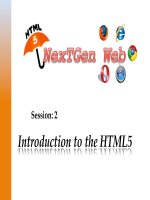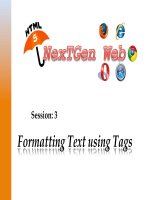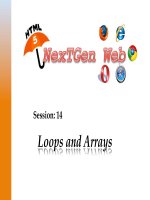HTML5 XP session 12 kho tài liệu bách khoa
Bạn đang xem bản rút gọn của tài liệu. Xem và tải ngay bản đầy đủ của tài liệu tại đây (9.54 MB, 61 trang )
Session: 12
Introduction to JavaScript
! Explain"scrip,ng"
! Explain"the"JavaScript"language"
! Explain"the"client
! Describe"the"JavaScript"methods"to"display"informa,on"
! Explain"escape"sequences"and"built"in"func,ons"in"JavaScript"
! Explain"events"and"event"handling"
! Explain"jQuery"
! Describe"how"to"use"the"jQuery"Mobile"
©"Aptech'Ltd.''
Introduc,on"to"JavaScript"/"Session"12""
2"
Scripting refers to a series of commands that are interpreted and executed sequentially
and immediately on occurrence of an event.
This event is an action generated by a user while interacting with a Web page.
Examples of events include button clicks, selecting a product from a menu, and so on.
A scripting language refers to a set of instructions that provides some functionality when
the user interacts with a Web page.
Scripting languages are often embedded in the HTML pages to change the behavior of
the Web pages according to the user’s requirements.
©"Aptech'Ltd.''
Introduc,on"to"JavaScript"/"Session"12""
3"
! Following"figure"displays"the"need"for"scrip,ng."
©"Aptech'Ltd.''
Introduc,on"to"JavaScript"/"Session"12""
4"
! There"are"two"types"of"scrip,ng"languages."They"are"as"follows:"
Client-side Scripting:
• Refers to a script being executed on the client’s machine by the browser.
Server-side Scripting:
• Refers to a script being executed on a Web server to generate dynamic
HTML pages.
! Following"figure"displays"the"types"of"scrip,ng."
Scripting
Client-side
Scripting
©"Aptech'Ltd.''
Server-side
Scripting
Introduc,on"to"JavaScript"/"Session"12""
5"
JavaScript is a scripting language that allows building dynamic Web pages by ensuring
maximum user interactivity.
JavaScript language is an object-based language, which means that it provides objects for
specifying functionalities.
In real life, an object is a visible entity such as a car or a table having some
characteristics and capable of performing certain actions.
Similarly, in a scripting language, an object has a unique identity, state, and behavior.
The identity of the object distinguishes it from the other objects of the same type.
The state of the object refers to its characteristics, whereas the behavior of the object
consists of its possible actions.
The object stores its identity and state in fields (also called variables) and exposes its
behavior through functions (actions).
©"Aptech'Ltd.''
Introduc,on"to"JavaScript"/"Session"12""
6"
! Following"figure"displays"some"real"world"objects."
©"Aptech'Ltd.''
Introduc,on"to"JavaScript"/"Session"12""
7"
! The"first"version"of"JavaScript"was"developed"by"Brendan"Eich"at"Netscape"in"1995"
and"was"named"JavaScript"1.0.""
! Following"table"lists"the"various"versions"of"JavaScript"language."
!
Version!
!
Descrip,on!
1.1
Is supported from 3.0 version of the Netscape Navigator and Internet Explorer.
1.2
Is supported by the Internet Explorer from version 4.0.
1.3
Is supported by the Internet Explorer from version 5.0, Netscape Navigator from version 4.0, and
Opera from version 5.0.
1.4
Is supported by servers of Netscape and Opera 6.
1.5
Is supported by the Internet Explorer from version 6.0, Netscape Navigator from version 6.0, and
Mozilla Firefox from version 1.0.
1.6
Is supported in the latest versions of the Internet Explorer and Netscape Navigator browsers. It is also
supported by Mozilla Firefox from version 1.5.
1.7
Is supported in the latest versions of the Internet Explorer and Netscape Navigator browsers. It is also
supported by Mozilla Firefox from version 2.0.
©"Aptech'Ltd.''
Introduc,on"to"JavaScript"/"Session"12""
8"
A Client-side JavaScript (CSJS) is executed by the browser on the user’s workstation.
A client-side script might contain instructions for the browser to handle user interactivity.
These instructions might be to change the look or content of the Web page based on the
user inputs.
Examples include displaying a welcome page with the user name, displaying date and
time, validating that the required user details are filled, and so on.
A JavaScript is either embedded in an HTML page or is separately defined in a file,
which is saved with .js extension.
In client-side scripting, when an HTML is requested, the Web server sends all the
required files to the user’s computer.
The Web browser executes the script and displays the HTML page to the user along with
any tangible output of the script.
©"Aptech'Ltd.''
Introduc,on"to"JavaScript"/"Session"12""
9"
! Following"figure"displays"the"output"of"a"client
©"Aptech'Ltd.''
Introduc,on"to"JavaScript"/"Session"12""
10"
A Server-side JavaScript (SSJS) is executed by the Web server when an HTML page is
requested by a user and the output is displayed by the browser.
A server-side JavaScript can interact with the database, fetch the required information
specific to the user, and display it to the user.
Server-side scripting fulfills the goal of providing dynamic content in Web pages.
Unlike client-side JavaScript, HTML pages using server-side JavaScript are compiled
into bytecode files on the server.
A JavaScript is either embedded in an HTML page or is separately defined in a file,
which is saved with .js extension.
Compilation is a process of converting the code into machine-independent code.
This machine-independent code is known as the bytecode, which is an executable file
that the Web server runs to generate the desired output.
©"Aptech'Ltd.''
Introduc,on"to"JavaScript"/"Session"12""
11"
! Following"figure"displays"the"output"of"a"client
©"Aptech'Ltd.''
Introduc,on"to"JavaScript"/"Session"12""
12"
The <script> tag defines a script for an HTML page to make them interactive.
The browser that supports scripts interprets and executes the script specified under the
<script> tag when the page loads in the browser.
You can directly insert a JavaScript code under the <script> tag.
You can define multiple <script> tags either in the <head> or in the <body> elements of
an HTML page.
In HTML5, the type attribute specifying the scripting language is no longer required as it
is optional.
©"Aptech'Ltd.''
Introduc,on"to"JavaScript"/"Session"12""
13"
! The"Code"Snippet"demonstrates"the"use"of"the"tag."
<!doctype html>
<html>
<head>
<script>
document.write(“Welcome to the Digital World”);
</script>
</head>
<body>
.....
</body>
</html>
There are two main purposes of the <script> tag, which are as follows:
Iden,fies"a"given"segment"of"script"in"the"HTML"page."
Loads"an"external"script"file."
©"Aptech'Ltd.''
Introduc,on"to"JavaScript"/"Session"12""
14"
A variable refers to a symbolic name that holds a value, which keeps changing.
For example, age of a student and salary of an employee can be treated as variables.
In JavaScript, a variable is a unique location in computer’s memory that stores a value
and has a unique name.
The name of the variable is used to access and read the value stored in it.
A variable can store different types of data such as a character, a number, or a string.
©"Aptech'Ltd.''
Introduc,on"to"JavaScript"/"Session"12""
15"
! Declaring"a"variable"refers"to"crea,ng"a"variable"by"specifying"the"variable"name."
! For"example,"one"can"create"a"variable"named"to"store"the"name"of"a"student."
In JavaScript,
the"var"keyword"is"used"to"create"a"variable"by"alloca,ng"memory"to"it."
a"keyword"is"a"reserved"word"that"holds"a"special"meaning.""
the"variable"can"be"ini,alized"at"the",me"of"crea,ng"the"variable"or"later."
ini,aliza,on"refers"to"the"task"of"assigning"a"value"to"a"variable."
once"the"variable"is"ini,alized,"you"can"change"the"value"of"a"variable"as"required."
variables"allow"keeping"track"of"data"during"the"execu,on"of"the"script."
while"referring"to"a"variable,"you"are"referring"to"the"value"of"that"variable."
one"can"declare"and"ini,alize"mul,ple"variables"in"a"single"statement."
©"Aptech'Ltd.''
Introduc,on"to"JavaScript"/"Session"12""
16"
! Following"figure"displays"how"to"declare"variables."
value
name
100
studID
! Following"syntax"demonstrates"how"to"declare"variables"in"JavaScript."
Syntax:!
var <variableName>;
where,"
" var:"Is"the"keyword"in"JavaScript."
" variableName:"Is"a"valid"variable"name."
©"Aptech'Ltd.''
Introduc,on"to"JavaScript"/"Session"12""
17"
! Following"syntax"demonstrates"how"to"ini,alize"variables"in"JavaScript."
Syntax:!
<variableName> = <value>;
where,"
" =:"Is"the"assignment"operator"used"to"assign"values."
" value:"Is"the"data"that"is"to"be"stored"in"the"variable."
! The"syntax"demonstrates"how"to"declare"and"ini,alize"mul,ple"variables"in"a"single"
statement,"which"are"separated"by"commas."
Syntax:!
var <variableName1> = <value1>, <variableName2> = <value2>;
©"Aptech'Ltd.''
Introduc,on"to"JavaScript"/"Session"12""
18"
! The"Code"Snippet"declares"two"variables"namely,"studID"and"studName"and"
assign"values"to"them."
var studID;
var studName;
studID = 50;
studName = “David Fernando”;
! The"snippet"assigns"values"to"studID"and"studName"variables"by"using"the"
assignment"operator"(=).""
! The"value"named"David Fernando"is"specified"within"double"quotes."
! The"Code"Snippet"demonstrates"how"to"declare"and"ini,alize"mul,ple"variables"in"a"
single"statement"in"JavaScript."
var studName = David, studAge = 15;
©"Aptech'Ltd.''
Introduc,on"to"JavaScript"/"Session"12""
19"
! JavaScript"is"a"case
! JavaScript"consists"of"certain"rules"for"naming"a"variable"as"follows:"
In JavaScript, a variable name
can"consist"of"digits,"underscore,"and"alphabets."
must"begin"with"a"le`er"or"the"underscore"character.""
cannot"begin"with"a"number"and"cannot"contain"any"punctua,on"marks."
cannot"contain"any"kind"of"special"characters"such"as"+,"*,"%,"and"so"on."
cannot"contain"spaces."
cannot"be"a"JavaScript"keyword."
©"Aptech'Ltd.''
Introduc,on"to"JavaScript"/"Session"12""
20"
! To"iden,fy"the"type"of"data"that"can"be"stored"in"a"variable,"JavaScript"provides"
different"data"types."
! Data"types"in"JavaScript"are"classified"into"two"broad"categories"namely,"primi,ve"
and"composite"data"types.""
! Primi,ve"data"types"contain"only"a"single"value,"whereas"the"composite"data"types"
contain"a"group"of"values."
# PRIMITIVE!DATA!TYPES""
! A"primi,ve"data"type"contains"a"single"literal"value"such"as"a"number"or"a"
string.""
! A"literal"is"a"sta,c"value"that"you"can"assign"to"variables."
©"Aptech'Ltd.''
Introduc,on"to"JavaScript"/"Session"12""
21"
! Following"table"lists"the"primi,ve"data"types."
Primitive
Description
Data Type
boolean
Contains only two values namely, true or false
null
Contains only one value namely, null. A variable of this value specifies that the
variable has no value. This null value is a keyword and it is not the same as the
value, zero
number
Contains positive and negative numbers and numbers with decimal point. Some of
the valid examples include 6, 7.5, -8, 7.5e-3, and so on
string
Contains alphanumeric characters in single or double quotation marks. The single
quotes is used to represent a string, which itself consists of quotation marks. A set of
quotes without any characters within it is known as the null string
©"Aptech'Ltd.''
Introduc,on"to"JavaScript"/"Session"12""
22"
# COMPOSITE!DATA!TYPES""
! A"composite"data"type"stores"a"collec,on"of"mul,ple"related"values,"unlike"
primi,ve"data"types.""
! In"JavaScript,"all"composite"data"types"are"treated"as"objects.""
! A"composite"data"type"can"be"either"predefined"or"user
Composite
Description
Data Type
Objects
Refers to a collection of properties and functions. Properties specify the
characteristics and functions determine the behavior of a JavaScript object
Functions
Refers to a collection of statements, which are instructions to achieve a specific
task
Arrays
Refers to a collection of values stored in adjacent memory locations
©"Aptech'Ltd.''
Introduc,on"to"JavaScript"/"Session"12""
23"
! JavaScript"allows"you"to"display"informa,on"using"the"methods"of"the"document"
object.""
! The" document" object" is" a" predefined" object" in" JavaScript," which" represents" the"
HTML"page"and"allows"managing"the"page"dynamically.""
! Each"object"in"JavaScript"consists"of"methods,"that"fulfill"a"specific"task."
! There"are"two"methods"of"the"document"object,"that"display"any"type"of"data"in"
the"browser."These"methods"are"as"follows:"
" write():"Displays"any"type"of"data."
" writeln():"Displays"any"type"of"data"and"appends"a"new"line"character.""
syntax" demonstrates" the" use" of" document.write()" method," which"
! The"
allows"you"to"display"informa,on"in"the"displayed"HTML"page."
Syntax:!
document.write(“<data>” + variables);
where,"
" data:"Specifies"strings"enclosed"in"double"quotes."
" variables:"Specify"variable"names"whose"value"should"be"displayed"on"the"
HTML"page."
©"Aptech'Ltd.''
Introduc,on"to"JavaScript"/"Session"12""
24"
syntax" demonstrates" the" use" of" document.writeln()" method," which"
! The"
appends"a"new"line"character."
Syntax:!
document.writeln(“<data>” + variables);
! The"Code"Snippet"demonstrates"the"use"of"write()"method."
<!DOCTYPE HTML>
<html>
<head>
<title> JavaScript language </title>
<script>
document.write(“
JavaScript:”);
document.writeln(“is a scripting”);
document.write(“and a case-sensitive language.”);
</script>
</head>
JavaScript: is a scripting and a case-sensitive language.
</html>
©"Aptech'Ltd.''
Introduc,on"to"JavaScript"/"Session"12""
25"









